Confession: I used to spend a week teaching affixes (prefixes and suffixes) and then another couple of weeks teaching roots. I’d assess and we’d move on to my next language/grammar standard. Sure, I may have spiraled them through grammar review and even mentioned them implicitly if it came up in texts we were reading. But I didn’t explicitly plan for morphology instruction. Because of this, I missed a great opportunity to help my students become better readers.
Does this sound like your experience with teaching affixes and roots? If so, this post will share some possibilities and the “power” of teaching morphology, including using it to help students with vocabulary, decoding, and spelling.
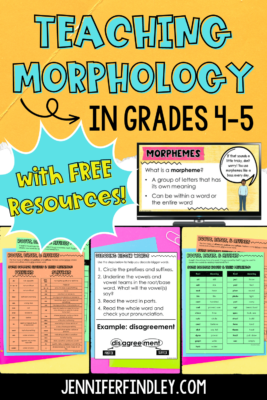
What is Morphology?
Morphology is the study of word structure. A morpheme is a group of letters that has its own meaning. The letters can be within a word or the entire word.
Examples:
The word distrust has two morphemes: “dis” and “trust.”
The word books has two morphemes: “book” and “s.”
Morphology instruction begins as early as 1st grade when students are taught about plural endings and past tense endings.
Teaching morphology can help students unlock the structure and meaning of unknown words they encounter as they are reading (and writing). Let’s look at some more background information on morphemes and then how having a morphology study in your classroom can help students.
Different Types of Morphemes
Free vs Bound Morpheme
Remember that a morpheme is a group of letters that hold meaning. This can be a single word (free morpheme) or parts of words (bound morphemes). Bound morphemes are affixes and roots that cannot stand on their own. They must be connected to another morpheme.
Types of Affixes
An affix is a type of morpheme. An affix is a group of letters added to the beginning or end of a word to change its meaning.
The two main types of affixes are prefixes and suffixes. Prefixes come before a base word, and suffixes come after a base word. Both prefixes and suffixes change the meaning of a word BUT prefixes never change the part of speech. Suffixes can (but not all of them do) change the part of speech.
There are two different types of affixes:
Inflectional: change the form or usage of the word. They can pluralize the word, change the verb tense, show possession, or show comparison. In most cases, these do not change the part of speech. Only suffixes are inflectional. Examples: -s, -es, -ed, -ing. These are taught very early on in the primary grades.
Derivational: create new words with different meanings and sometimes different parts of speech. Both prefixes and suffixes can be derivational, but only suffixes change the part of speech of a word.
It is not important for students to know these terms or even to be able to define/identify them. However, it is important to ensure that you are teaching both types of suffixes. Inflectional suffixes are taught as early as kindergarten/first grade, and derivational suffixes are ongoing. Check out this post from Linguistics Girl for more information and lots of examples for both inflectional and derivational affixes.
Base Words and Roots
A base word is a word that can stand alone and hold meaning. It can also have an affix added to it to create a new word. Examples: hope, like, trust, appear. These are all base words and can stand alone. Affixes can also be added to them to make new words.
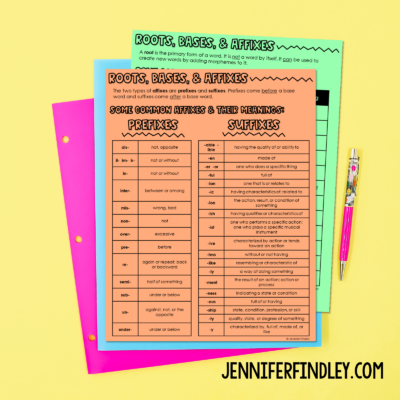
A root is the primary form of a word. Unlike a base word, it cannot stand on its own. However, like a base word, you can add morphemes to it to create words. Examples: aud, bio, dict, graph
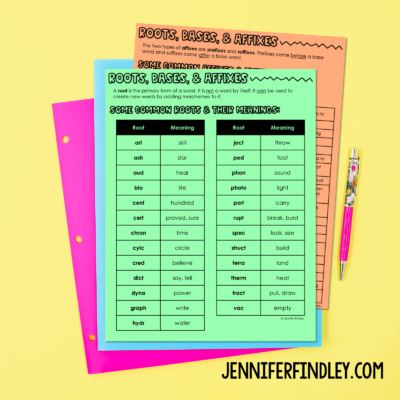
Teaching Morphology: Defining Words
Most students are only able to explicitly learn about 8-10 new words a week through direct instruction. Morphology gives another avenue for students to strengthen their vocabulary.
When students are presented with unknown or new words while reading, they can use their knowledge of prefixes, roots/base word, and suffixes to determine the meaning of the word OR to get a general understanding of the word.
Example: overexcite
- Excite means cause strong feelings of enthusiasm.
- Over means excessive or too much.
“Overexcite” means excessive feelings of enthusiasm.
Example: thermal
- Therm means heat.
- Al means relating to.
“Thermal” means relating to heat.
A Note of Caution: There are some limitations to using morphemes to define unknown words if students use it as their only strategy. Some affixes have more than one meaning (in- and -en). Also, sometimes removing a prefix or suffix does not help with determining the meaning of a word (example: grateful – full of grate is not helpful). Some words may appear to have prefixes and suffixes but do not (uncle, missile, repeat). Explicitly going over a few examples with students AND reminding them of the importance of context is important to avoid these problems.
Teaching Morphology: Decoding Words
Finding morphemes in a word can not only help students find the meaning of a word, but it can also help them decode words to easily read them.
When students are presented with multisyllabic words, they can break them into more manageable morpheme chunks. This helps when reading a long or complicated word. It is far more efficient than sounding out each letter and often more efficient than breaking the word in syllables.
Because morphemes also carry meaning, the students will be breaking the word apart in a way that aids both decoding and understanding.
Examples:
unfeelingness
un feel ing ness
disagreement
dis agree ment
unselfishness
un self ish ness
Decoding Strategy Using a Morphological Approach
Here are some steps you can teach your students that will help them when decoding words using a morphological approach.
- Circle the prefixes and suffixes.
- Underline the vowels and vowel teams in the base/root word. What will the vowel(s) say?
- Read the word in parts (morphemes or syllables).
- Read the whole word and check/tweak your pronunciation.

Instructional Strategy: Decoding Words with a Common Base
Another instructional approach is to use base word families. This helps with decoding and fluency. Present a list of words with a common base. Read and discuss the common base. Then analyze the list of words with the base and find (and circle) the prefixes and suffixes. Students can then more easily decode and read the words.
Teaching Morphology: Helps with Spelling
There are so many rules to remember when it comes to spelling. When adding suffixes to words, there can be some spelling changes for students to learn. Knowing how suffixes impact base words and learning the rules explicitly can help students become better spellers.
Example spelling rules with suffixes:
1. When you have a short vowel and then a consonant, you double the consonant before you add the suffix. Example: “beginning” or “funny.”
2. When you have multiple syllable words that end in “L,” double the “L” before you add the suffix. Example: “repelling” or “controller.”
3. Sometimes when you are adding a suffix to a word that ends in “y,” you drop the “y” and add an “i.” Example: “happiness” or “pitiful.” (There are some exceptions to this rule, like when there is a vowel right before the “y,” as in “joyful.” Or when the suffix that you are adding begins with an “i,” like in “saying.”)
4. Sometimes we change an “ie” to a “y” before adding the suffix. Example: “lying” or “tying.”
An understanding of assimilated (chameleon) prefixes will also help with spelling. Assimilated prefixes are prefixes that have the same meaning but are spelled differently to make pronouncing the word easier.
Examples: in, im-, il-, and ir- all mean “not.” The one that is used depends on the first consonant of the base being added. You would not say inregular, you would say irregular.
Teaching Morphology: It’s Engaging!
Learning morphology can be fun! Creating new words, playing with words, and discovering words are all things we want our students to do and enjoy doing. Explicitly teaching morphology and morphology activities can help with that.
Tips for Teaching Morphology
Tip 1: Start with frequently used/common prefixes and suffixes. These are the ones seen often in reading and ones that students can easily learn and remember.
Tip 2: Begin with transparent morphemes/relationships (versus opaque).
Transparent morphemes are those with clear meanings that are easy for students to uncover and even visualize. They also do not have spelling or sound shifts with the base word. Examples: happy to unhappy, swim to swimming, heard to misheard, teach to teacher, music to musical.
Opaque morphemes, on the other hand, can be harder for students to see the connection between the morphemes and the meaning. Example: exhale, grateful, and bashful. They also may have shifts in pronunciation of the base word (sign to signature) or shifts in spelling (pity to pitiful) that make it more difficult for students to “see” the relationship.
Tip 3: Teach affixes with common base words (and not root words) to begin with.
Tip 4: Teach affixes and roots early on in the school year so you can study and explore them all year.
Tip 5: The easiest way to begin morphology instruction, if you think your readers may struggle, is with compound words. Compound words are the perfect way to introduce the study of morphology with students who may struggle.
How Do You Fit Morphology Instruction In?
It can definitely be a struggle to fit in morphology and all the different aspects of it, but the payoff is worth it.
Here are some ways you can squeeze in some morphology instruction into your existing schedule/curriculum:
1. Morphology Warmups – Use morphology activities to start your small group or whole group reading lessons.
2. Daily Routine – Have a quick daily routine where you learn about and practice using an affix or root. Click here to see my Grammar of the Day resources that include a Prefix and Suffix of the Day and a Root of the Day.
3. Word Study Centers/Reading Centers – If you use centers, using morphology activities in a word study center is a great way to incorporate it AND engage your students. Activities such as morphology sorts, unscramble the morphemes, and morphology word matrixes are great options for word study centers.
4. Spelling – Long gone are the days of random words on a spelling list that students have no choice but to memorize. Now, spelling is more effective when it focuses on patterns. Those patterns can be advanced phonics patterns OR morphological connections.
Want FREE Morphology Resources to Introduce the Topic?
To help you introduce morphology to your students, I have a free presentation to share.
The presentation is broken down into sections. Choose the sections that work for your students and their current learning needs. Some sections are great for all students, and some are more advanced. Some of the sections you may skip entirely (or just use for your own learning).
- Introduction to Morphology
- Using Morphemes to Define Words
- Using Morphemes to Decode Words
- Creating New Words with Affixes
- Spelling Changes with Suffixes
- Shifts in Pronunciations
There are two different versions of the presentation you can choose from depending on your needs.
- The first presentation includes much more text on each slide. It could be used as a reference for your students since it requires little additional information other than what is on the slide.
- The second presentation has less text and requires teacher-led discussion and support to understand and practice what is being presented. This version also includes a companion guide with prompts, additional information, and guided practice
In addition to the presentation, there are also student notes and cheat sheets that go along with the presentation (or can be used separately).
To grab this free teaching morphology presentation, click the animated image below and then enter your email address in the pop-up. You’ll be able to download the resource immediately and it will also be sent to your inbox. From there you will have access to the student printables, teacher guide (for the less text version), and links to the Google Slides presentations.
Want MORE morphology activities and resources?
Want to easily incorporate morphology into your instruction in just minutes? Try morphology warmups! Or check out the activities bundle of my favorite resources for practicing morphology in a variety of ways all year long! Digital and printable versions are included for flexibility.
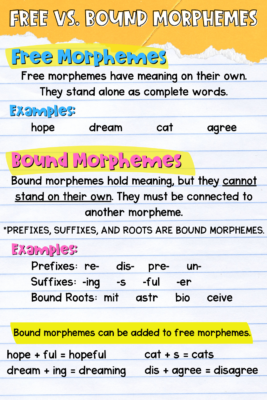
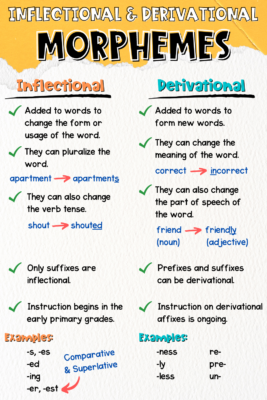
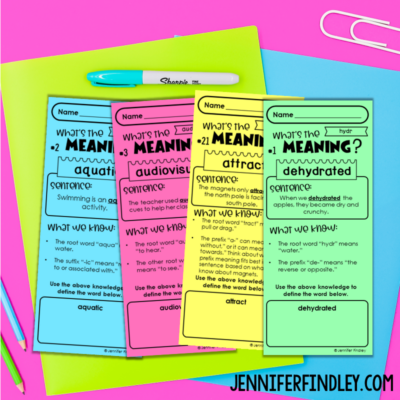
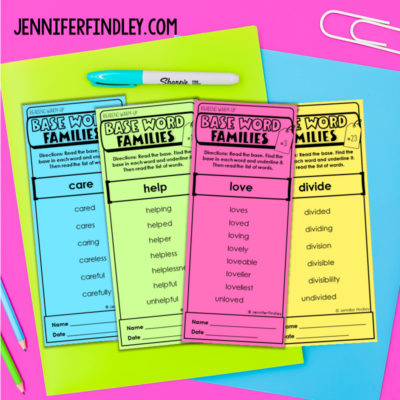
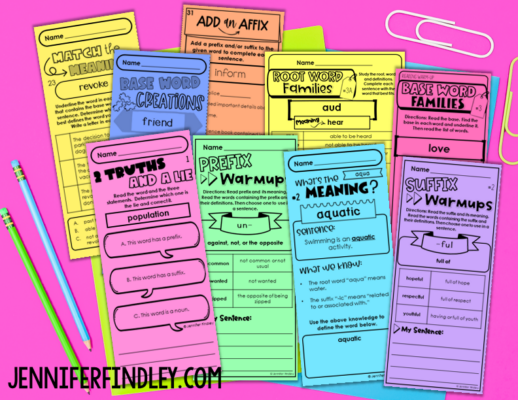

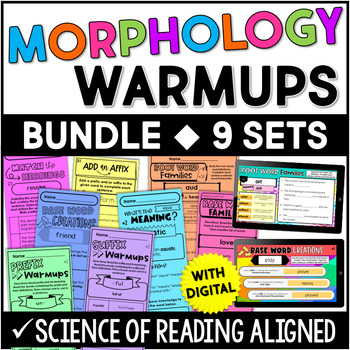








Thank you for all the information!
I love your resources! How did you decide on the sequence??
Hi Nicole, a few ways:
– how common the morpheme was
– what bases or roots the morpheme commonly affixed to. For example, the prefix con and its assimilations have a straightforward meaning. However, they affix to mostly roots so they are best for older grades.
– how concrete vs abstract the meaning of the morpheme was
Thanks for asking!
Looking for some structured word inquiry – hopefully this will be a way in 🙂
Hi Jennifer,
I would like to receive the presentation on morphology.
Thank you,
Odelia
Hi Odelia, Did you enter your email in this section: Want FREE Morphology Resources to Introduce the Topic?
The presentation will be sent to your email.
Love this!
Awesome resources, thanks!